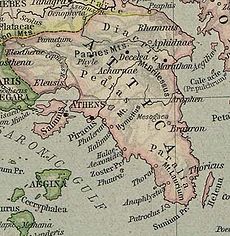THeseus
Attica
Attica is an ancient region of Greece which includes Athens. Its early kings are mentioned by Plato (Critias 110 a-b)
“The Egyptian priests, in describing the war of that period, mentioned most of those names – such as those of Cecrops and Erechtheus and Erichthonius and Erisichthon and most of the other names which are recorded of the various heroes before Theseus.” Building on that and the writings of Pausanias (Graeciae Descriptio 1,2,6) and Apollodorus (Bibliotheca 3.14.1)(b), Stavros Marinopoulos has constructed an Attica king-list – Actaeus, Cecrops, Erysichthon, Cranaus (3.14.5), Erichthonius, Pandion, Erechtheus, Cecrops II, Pandion II, Aegeus and Theseus(a). Although some disagree with the details of this list claiming, for example, that Cecrops and Pandion I and II are duplications, that Erysichthon died before Cecrops died and that Amphictyon succeeded Cranaus, his reconstruction is probably largely correct.
Building on that and the writings of Pausanias (Graeciae Descriptio 1,2,6) and Apollodorus (Bibliotheca 3.14.1)(b), Stavros Marinopoulos has constructed an Attica king-list – Actaeus, Cecrops, Erysichthon, Cranaus (3.14.5), Erichthonius, Pandion, Erechtheus, Cecrops II, Pandion II, Aegeus and Theseus(a). Although some disagree with the details of this list claiming, for example, that Cecrops and Pandion I and II are duplications, that Erysichthon died before Cecrops died and that Amphictyon succeeded Cranaus, his reconstruction is probably largely correct.
From this, Papamarinopoulos concluded that the kings who opposed the Atlanteans lived in the 16th century BC. Other sources(c) put their reign from the 15th to the 13th centuries BC, so although there are relatively minor differences between commentators, there is a consensus that the 2nd millennium BC was the time of these early kings, but very definitely not the 10th millennium BC. As you will see elsewhere, the Parian Marble substantially supports many elements of Papamarinopoulos’ analysis.
(b) https://www.theoi.com/Text/Apollodorus3.html
(c) Greek Kings Lists (archive.org) *
Panathenaea
Panathenaea was an important annual festival of Pallas Athene that according to tradition dated from the time of the legendary king Theseus. From 566 BC Pisistratus, the Athenian aristocrat, arranged that every fourth year, when the festival would be known as the Greater Panathenaea, music and poetry competitions were included, together with games and the festival was extended by three or four days.
During annual Lesser Panathenaea there was a solemn procession to the Acropolis in thanksgiving to Athene for having saved the city, giving it victory over the ‘nation of Poseidon’. Ammianus Marcellinus recounts how the peplum, a richly embroidered robe of Minerva (the Roman equivalent of Athena) was carried in this procession, on which could be seen a representation of the war between the Athenians and the Atlantides. That this was a clear reference to the defeat of the Atlanteans is supported by Humboldt, Böckh, Donnelly[1179.91], Baldwin[0653.396] and Joseph.
*Justin Winsor relates the same story with some minor changes “In the Scholia to Plato’s Republic it is said that at the great Panathenaea there was carried in procession a peplum ornamented with representations of the contest between the giants and the gods, while on the peplum carried in the little Panathenaea could be seen the war of the Athenians against the Atlantides. Even Humboldt accepted this as an independent testimony in favor of the antiquity of the story ; but Martin has shown that, apart from the total inconsistency of the report with the expressions of Plato, who places the narration of this forgotten deed of his countrymen at the celebration of the festival of the little Panathenaea, the scholiast has only is read Proclus, who states that the peplum depicted the repulse of the barbarians, i.e. Persians, by the Greeks.” [1673.1.42]
The Persian interpretation is a minority view, which is greatly weakened by the fact that this ceremony was performed at least 138 years before Plato was even born would appear to demonstrate that he could not have invented the existence of Atlantis and in fact the celebratory procession was inaugurated long before the Persian Wars began. Apart from that, the ancient Greeks arrogantly referred to all non-Greeks as ‘barbarians’ and could, in this instance, be applied more aptly to the Atlanteans rather than the Persians.*
The Parian Marble allows us to calculate the date of the first Panathenaea occurring in 1506/5 BC. If ‘the nation of Poseidon’ is not a reference to Atlantis, what does it refer to? One suggestion, perhaps more contentious, is that it is an illusion to the Sea Peoples.
The contest between Athena and Poseidon on the West pediment of the Acropolis is related to the later conflict between Erechtheus, an early king of Athens, and the Eleusinians under the leadership of Eumolpos. Keep in mind that Poseidon is the father of Eumolpos, dated by some to reigning around 1400 BC.
New research by Professor Efrosyni Boutsikas of the University of Kent has shown(a) that the start of the annual festival was signalled by the appearance of the Draco constellation over the Erechtheion on the Acropolis of Athens.
(a) https://www.unreportedheritagenews.com/2011/04/rising-above-acropolis-constellation.html
